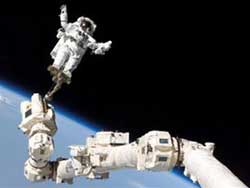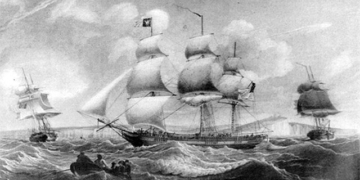 Finally, the Discovery shuttle is set to launch into space on July 1, 2006, despite ongoing debates. There are significant concerns about potential catastrophic accidents occurring with these aging shuttles (Discovery’s first flight was on August 30, 1984).
Finally, the Discovery shuttle is set to launch into space on July 1, 2006, despite ongoing debates. There are significant concerns about potential catastrophic accidents occurring with these aging shuttles (Discovery’s first flight was on August 30, 1984).
Some “defensive” opinions suggest that the shuttle will be safe due to repairs and upgrades. However, there is a larger issue at stake: the reality that the United States does not have any spacecraft to replace the current shuttle fleet until 2012, and it cannot halt space exploration launches to allow Russia to gain the “upper hand.”
The solution of repairing and upgrading the shuttle is the only viable option the U.S. must choose at this time. The Columbia shuttle disaster in February 2003 resulted in the deaths of all seven crew members. Investigations revealed that the main cause was a piece of insulation from the fuel tank that fell off and struck the left wing, damaging the thermal protection system and causing the shuttle to disintegrate upon re-entry to Earth.
Based on images captured during most launches, NASA engineers have been able to identify potential risks. The most concerning is the possibility of insulation tiles from the fuel tank peeling off or ice chunks forming on fuel lines falling and damaging the shuttle’s thermal protection system. After a period of modifications and repairs, a test flight in July 2005 encountered a similar accident, where a piece of insulation from the fuel tank fell but did not hit the shuttle’s body.
Since then, after multiple delays and repairs, NASA believes it has achieved several important improvements that could allow for continued launches. These improvements include:
– Adjusting the shuttle attachment system. This is the system that secures the shuttle to the fuel tank. The insulation on the fuel tank is now thicker. The new design aims to prevent insulation pieces from falling off and eliminates the risk of ice formation using electric heaters.
– The fuel tank, which contains liquid oxygen and hydrogen, has also been upgraded to avoid the shedding of insulation tiles.
– Improvements in the method of attaching insulation tiles have been made to reduce cases of shedding, which has been a common cause of problems during launches.
– Upgraded connection bolts. Under the new design, these bolts remain secure when the two solid rocket boosters separate from the fuel tank.
– Immediately after the two boosters detach from the fuel tank, a secondary rocket ignites to push them away from both the fuel tank and the shuttle, avoiding collisions.
– Two cameras mounted on the boosters monitor the wings and belly of the shuttle. This footage will serve as a “black box,” allowing for post-recovery assessments of the boosters from the ocean.
– NASA has also installed nine new cameras. A small camera mounted on the fuel tank captures real-time images of the shuttle and its wing edges. The camera has switched from film to digital format, allowing images to be transmitted immediately back to Earth during the flight.
– A camera and a laser inspection system are mounted at the end of the robotic arm. This enhancement doubles the reach of the robotic arm to 100 feet, allowing astronauts to inspect any exterior damage.
– Each leading edge of the shuttle’s wings is equipped with 22 thermal sensors to measure temperature. Each wing has 66 accelerometers to detect impacts and their intensity. Additionally, thermal sensors are mounted on the attachment system, and vibration sensors are attached to the fuel tank. Data from these sensors will be used to calculate the safety performance of the tank.
– Upon the shuttle’s return to Earth, technicians will use infrared spectroscopy to examine each tile for heat damage on the leading edges of the shuttle’s wings, checking for burns, explosions, and cracks during re-entry under extreme high temperatures.
– The shuttle is equipped with 24,300 thermal protection tiles. To repair minor damages on these tiles, astronauts can apply a gray substance, similar to spray adhesive, increasing the tiles’ durability during re-entry.
– For small damages on the wings, astronauts can use a spray gun to inject a compound similar to mortar into cracks. After applying this heat-resistant black compound, a special knife can be used to smooth the surface of the crack. For holes in carbon panels, patch layers known as RCC can now be applied to seal and secure the bolts.
– For gaps in insulation tiles, a covering tool can be used. This is a flexible material made of silicon carbide that can be attached to holes with screws.
– To protect the liquid oxygen lines (five lines leading into the combustion chamber) that are prone to freezing, previously exposed metal tubes are now shielded with a special gel and a fiberglass layer.
NASA is confident that with these improvements, the Discovery shuttle will be able to safely launch into space and return.
NGÔ ĐƯỢC


















































